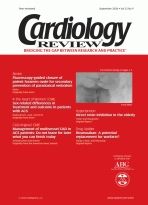Publication
Article
Cardiology Review® Online
Mechanistic learnings of takotsubo for make benefit glorious cardiomyopathy
Author(s):
Despite advances in echocardiography, magnetic resonance imaging, and the ability to perform an endomyocardial biopsy, the underlying etiology of nonischemic left ventricular (LV) dysfunction often eludes clinical detection.
Despite advances in echocardiography, magnetic resonance imaging, and the ability to perform an endomyocardial biopsy, the underlying etiology of nonischemic left ventricular (LV) dysfunction often eludes clinical detection.1 Takotsubo syndrome (also called apical ballooning) is a unique form of cardiomyopathy that tantalizes us with a rare glimpse into both the etiology and potential reversibility of myocardial dysfunction based on its association with adrenergic activation and its characteristic echocardiographic or ventriculographic appearance.
Although undoubtedly misdiagnosed as focal myocarditis or vasospasm prior to its description in a 1990 textbook by Sato,2 our appreciation for the existence of Takotsubo syndrome has escalated in tandem with our desire to understand its underlying cause (
). Takotsubo syndrome typically presents in a postmenopausal, emotionally or physically distressed woman reporting acute chest pain or dyspnea, and manifesting mild enzymatic evidence of myocardial damage. Clinically, it may mimic an acute myocardial infarction or ventricular tachycardia. Although angiography reveals the absence of significant epicardial coronary artery disease, echocardiography or ventriculography reveal an end-systolic ventricular “ballooning” that may be heterogeneous.3 The syndrome is strikingly reminiscent of conditions seen in experimental animals that occur after acute increases in afterload or with catecholamine excess. Indeed, both an intraventricular pressure gradient and catecholamine excess have been described in Takotsubo patients.4-7 Since additional mechanisms remain under consideration, including transient myocardial ischemia due to coronary vasospasm or difficult-to-detect thrombus in the territory of a “wrap around” left anterior descending artery (with its perfusion territory beyond the usual detection abilities of coronary angiography),8,9 microcirculatory abnormalities, and even genetic predilections, it would be reasonable to assume that multiple forms of the disease may exist.
The case report by Nwachukwa demonstrates the need for precise diagnostic criteria for Takotsubo cardiomyopathy for both clinical and basic science investigation.10 The indolent presentation in this case report (progressive fatigue, dyspnea on exertion, and bilateral lower extremity swelling) is less common than the more fulminant presentation marked by acute dyspnea, chest pain, and often, cardiac arrest. The history also reveals the presence of celiac sprue, which raises the possibility that the cardiomyopathy may have been triggered by an electrolyte deficiency9,11 or an anticardiolipin syndrome.12 Electrocardiographic abnormalities, mimicking an acute inferior wall myocardial infarction, were present and the combination of echocardiography and ventriculography revealed apical akinesis with midventricular hyperkinesis. Classically, no angiographic evidence of an obstructive coronary lesion was present. However, we are not told if states of adrenergic excess, including pheochromocytoma or central nervous system disorders, were ruled out. Moreover, we are not told of the follow-up for this patient and potential reversibility of the LV dysfunction. Classic Takotsubo cardiomyopathy is associated with recovery of LV function, usually within 2-4 weeks of presentation.
Many questions concerning Takotsubo cardiomyopathy remain for both clinical and basic science researchers. These include an understanding of the heterogeneity of presentation, the optimal nature and duration of treatment, and whether the unique properties of Takotsubo cardiomyopathy will offer a window to more fully understand other forms of cardiomyopathy.






